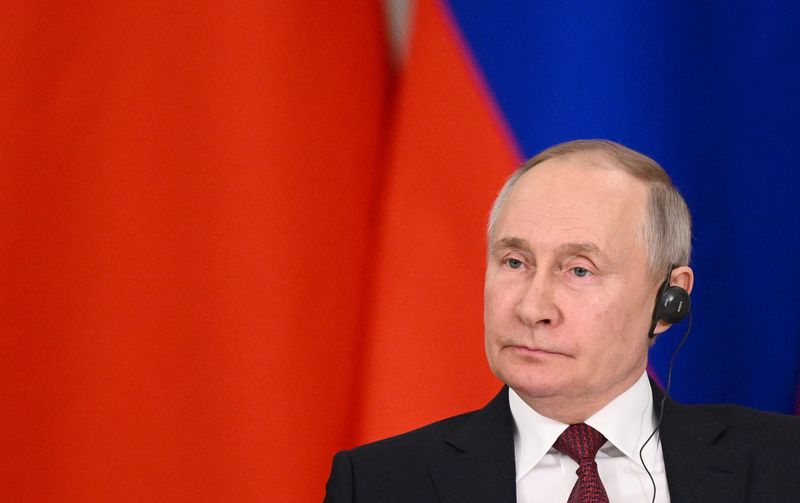By Guy Faulconbridge
(Reuters) -Russian President Vladimir Putin says Moscow has a deal to station tactical nuclear weapons in neighbouring Belarus and that this would not violate non-proliferation agreements.
What are these weapons and what is Russia's policy on them:
WHAT ARE THE CONCERNS
The United States has said the world faces the gravest nuclear danger since the 1962 Cuban Missile Crisis because of remarks by Putin during the Ukraine conflict, but Moscow says its position has been misinterpreted.
Kyiv and its Western allies fear tactical nuclear weapons could be used in battle after Putin and others warned Russia was prepared to use all its vast arsenal in defence.
HOW WOULD A NUCLEAR STRIKE BE PREPARED?
Many of Russia's delivery systems are dual-use, meaning they can be used to carry nuclear as well as conventional warheads.
This set-up makes it more difficult to spot preparations for a nuclear strike as these kinds of delivery weapons are already deployed to countries such as Ukraine, Belarus and the Russian enclave Kaliningrad.
Thus, one Western focus is on monitoring the whereabouts of the nuclear warheads, more specifically the depots where Russia is storing the warheads and whose locations are known.
NATO has always been keeping a very close eye on any activity around these depots, even more so since Moscow invaded Ukraine.
Preparations for a nuclear strike would show in heightened activity around the depots as arrangements would have to be made to move the warheads.
WHAT ABOUT KALININGRAD?
The West has been saying for a long time that Russia has deployed advanced nuclear-capable Iskander missiles to Kaliningrad, its Baltic coast enclave between NATO and European Union members Poland and Lithuania.
Launched from the enclave, these missiles could reach large parts of Western Europe.
Russia has threatened to station nuclear and hypersonic weapons in Kaliningrad should Finland and Sweden join NATO as they are in the process of doing.
WHAT ARE TACTICAL NUCLEAR WEAPONS?
Academics and arms control negotiators have spent years arguing about how to define tactical nuclear weapons (TNW). They are nuclear weapons used for specific tactical gains on the battlefield, rather than, say, destroying the biggest cities of the United States or Russia.
Few people know exactly how many TNW Russia has because it is an area still shrouded in traditions of Cold War secrecy.
Russia has a huge numerical superiority over the United States and the transatlantic NATO military alliance when it comes to TNW: the United States believes Russia has around 2,000 such working tactical warheads, 10 times more than Washington.
These warheads can be delivered via a variety of missiles, torpedoes and gravity bombs from naval, air or ground forces. They could even be simply driven into an area and detonated.
The United States has around 200 such weapons, half of which are at bases in Europe. These 12-ft B61 nuclear bombs, with different yields of 0.3 to 170 kilotons, are deployed at six air bases across Italy, Germany, Turkey, Belgium and the Netherlands.
The atomic bomb dropped by the United States on the Japanese city of Hiroshima in 1945 was about 15 kilotons.
WHO GIVES THE RUSSIAN LAUNCH ORDER?
The president is the ultimate decision maker when it comes to using Russian nuclear weapons, both strategic and non-strategic, according to Russia's nuclear doctrine.
When the Soviet Union collapsed in 1991, Russia had around 22,000 TNWs while the United States had around 11,500. Most of these weapons have been dismantled or are waiting to be dismantled.
The ones that remain are stored in at least 30 military bases and silos under the control of the 12th Main Directorate of the defence ministry (12th GUMO) headed by Igor Kolesnikov, who reports directly to the defence minister.
To prepare a TNW strike, it is likely that Putin would consult with senior allies from the Russian Security Council before ordering, via the general staff, that a warhead be joined with a delivery vehicle and prepared for a potential launch order.
Because Putin could not predict the U.S. response, Russia's entire nuclear posture would change: submarines would go to sea, missile forces would be put on full alert and strategic bombers would be visible at bases, ready for immediate takeoff.
STATIONING NUCLEAR WEAPONS
After the Soviet collapsed in 1991, the United States went to enormous efforts to return the Soviet nuclear weapons stationed in Belarus, Ukraine and Kazakhstan to Russia - which inherited the nuclear arsenal of the Soviet Union.
Since the weapons were returned in the early 1990s, Russia has not announced any nuclear weapon deployments outside its borders.

Putin said on Saturday the agreement with Belarus would not contravene non-proliferation agreements.
The Treaty on the Non-Proliferation of Nuclear Weapons, signed by the Soviet Union, says that no nuclear power can transfer nuclear weapons or technology to a non-nuclear power, but it does allow for the weapons to be deployed outside its borders but under its control - as with U.S. nuclear weapons in Europe.